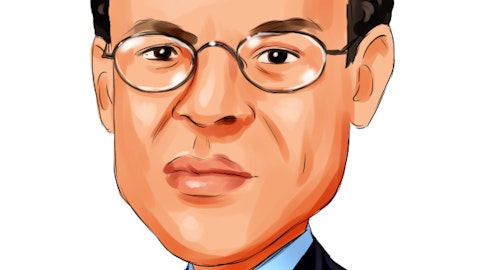Gaia, Inc. (NASDAQ:GAIA) Q4 2022 Earnings Call Transcript March 6, 2023
Operator: Good afternoon, everyone. And thank you for participating in today’s conference call to discuss Gaia Inc.’s Financial Results for the Fourth Quarter and Full Year Ended December 31, 2022. Joining us today are Gaia’s CEO, Jirka Rysavy; and CFO, Paul Tarell. Following some prepared remarks, we will open the call up for your questions. Before we get started, however, I would like to take a minute to read the Safe Harbor language. The following constitutes to Safe Harbor statement under the Private Securities Litigation Reform Act of 1995. The matters discussed today include forward-looking statements that involve numerous assumptions, risks and uncertainties. These include, but are not limited to, general business conditions, future losses, competition, loss of key personnel, price changes, membership growth, brand reputation, changing consumer preferences, customer acquisition costs, member retention rates, acquisitions and other risks and uncertainties detailed from time-to-time in our filings with the Securities and Exchange Commission, including our reports on Form 10-K and Form 10-Q.
Gaia assumes no obligation to publicly update or revise any forward-looking statements. With that, I would like to turn the call over to Gaia’s CEO, Jirka Rysavy. Please go ahead.
Jirka Rysavy: Thank you, and good afternoon, everyone. I’m glad that I can report some positive news. After the challenging 2022, Rainbow’s revenue and adjusted EBITDA increased only in single digit due to COVID lockdown members cleanup. We have already seen overall member growth in 2023. Growth came from our direct membership while the third party providers like Amazon were still negative in January and February. In 2022, revenue increased 3% to $82 million from $79.6 million in 2021 and member count ended December 31st at 759,000 members. Gross profit for 2022 increased to $71.1 million or 86.7% of revenue, up from $69 million in 2021. Adjusted EBITDA increased to $17.5 million from $16.8 million in prior year. During the last few months, we have eliminated over $5 million in annualized spending, which included approximately 36 headcounts, mostly contractors that were added over last two years to offset the reduced efficiency we experienced as a result from kind of work from home mandates.
We expect to see the benefits of the savings to begin in the second quarter. Our efforts in French and German markets started to generate meaningful results. And we also signed new agreement to launch Gaia on Amazon Mexico and Gaia also became part of new Google subscription venture YouTube Primetime. And of end of second quarter 2023, we also plan to launch a Gaia marketplace focusing on our existing member base to increase ARPU and revenue with only minimum marketing expense. Paul will now talk to about the results.
Paul Tarell: Revenues were up 30% for the year with fourth quarter revenues up $19.6 million. Gross margins improved for the fourth quarter to 86.7% from 85.8% in the year ago quarter. For the year, gross margins of 86.7% were relatively consistent with the prior year. As we continue to invest in and release new contents, particularly to support our growing language expansion efforts, we have increased our viewership on the exclusive portion of our content library to over 85%. We expect content amortization to bring expected gross margins down to the 85% level in 2023. Total member acquisition costs during the quarter were $7.7 million or 40% of revenues compared to $8.2 million or 39% of revenues in the year ago quarter. Despite the seasonal headwinds we typically experienced during the holiday season, we were able to reduce our per customer acquisition cost by approximately 10% from the prior year quarter, which led to growth in our direct member base during the fourth quarter.
We did however continue to experience net member base contraction in our larger third party distribution partners leading to an overall decline in our member base during the quarter. Based on third party analysis we received, this third party trend is not Gaia specific. Selling and operating expenses, excluding marketing and member acquisition costs in the fourth quarter were $8.2 million or 42% of revenues, which is up from the prior year due primarily to increased technology operating expenses. Corporate and G&A expenses in the fourth quarter were $1.6 million or 8% of revenues in line with the year ago quarter. We have implemented significant cost reduction measures over the past few months, as Jirka mentioned, which we will begin to see the benefits of during the second quarter of 2023.
We had a net loss of $0.9 million or $0.04 per share during the fourth quarter of 2022 compared to net income $2.1 million or $0.11 per share in the year ago period. The prior period reflected a tax benefit of $2 million due to a partial valuation allowance release triggered in connection with our acquisition of Yoga International. In 2022, we had a net loss of $3.1 million, which included an anticipated $2 million settlement accrual with the SEC that we announced with our third quarter 2022 results and the related legal fees. We are awaiting final approval from the commission on the proposed settlement and have no further updates at this time. With the proposed settlement, we anticipate our ongoing legal fees related to this matter will no longer be a headwind on earnings.
Excluding the anticipated settlement accrual and related legal fees, we had slightly positive net income for 2022. Adjusted EBITDA was $3.9 million or 20% of revenues in the quarter compared to $4.1 million or 20% of revenues in the year ago quarter. Adjusted EBITDA for the full year was $17.5 million or 21% of revenues compared to $16.8 million or 21% of revenues in 2021. Now that we have worked through the rapid growth and subsequent declines in our member base as a result of COVID, our working capital cycle has stabilized and we expect to begin to benefit from the negative working capital generated from our members’ upfront subscription payments. We will also benefit from the $5 million in reductions that Jirka mentioned on our expenses and we will be in a position to begin generating cash flows from operations in excess of the cash flows we reinvest back into our content library and products enhancements.
We expect this to allow us to begin generating cash flows during the year and provides flexibility for us to reinvest those cash flows for future growth or withstand a future downturn in the macroeconomic environment. We spent the past year adjusting to a rapidly evolving post-COVID environment to get ourselves back to a place of financial independence, rolled out our business continuity initiative to gain technological independence and are now focused on creating growth drivers to allow for marketing independence and sustained growth of revenues and cash flows. With that, I’ll hand it back to Jirka for some closing remarks.
Jirka Rysavy: Yes. Just for the summary, I want to say, we have no net debt and the replacement value of over 10,000 titles we fully own with the future cash value of our customer base it’s well over $300 million. And our cash balance as of December 31 was $11.6 million. And during 2023, we expect the business to generate about $7 million to $9 million of new cash. With that, I want to thank you everyone for joining. And we will look forward speaking with you on 2023. I want to open it for questions. Operator?
See also 15 Highest Yielding Dividend Stocks You Can Buy and 25 Best Countries to Invest In .
Q&A Session
Follow Gaia Inc (NASDAQ:GAIA)
Follow Gaia Inc (NASDAQ:GAIA)
Operator: Our first question comes from Mark Argento with Lake Street Capital.
Mark Argento: Just wanted to drill down a little bit on the $7 million to $9 million in free cash or cash generated for that you’re anticipating for 2023. What kind of subscriber growth does that contemplate? Just wanted to better dial that number in a little bit.
Jirka Rysavy: Well, we are going to refocus on the kind of subscriber stay longer, but let’s say that we want to be ahead of our peak, so before we lost any COVID customers. So we expect to grow above that but also to really launch the Gaia Marketplace, which basically allows the members to purchase different, mostly non-tangible services when Gaia keeps percentage. And so we did a survey to our customer base and over half of our customers are interested to participate. So those are between those two is this free cash flow generated. And so we expect to launch the Gaia Marketplace like end of the third quarter — end of the second quarter.
Paul Tarell: I’ll jump in a little bit. So we’re really focused, given how challenging the new customer acquisition has been with the changes that are constantly evolving in privacy and online advertising. We’re really focusing on trying to increase average revenue per user of our existing member base that at this point now has become very seasoned and sticky and looks to Gaia for guidance in terms of what content they watch, but now we see an opportunity to expand that into other, as Jirka mentioned, non-tangible and potentially tangible goods that fit into our ethos. We did evaluate looking at a AVOD model, which is what a lot of the other streaming players have moved into. And for us, it’s really not interesting given our brand ethos and the majority of advertising revenue coming from brands and industries that we wouldn’t want to take money from.
So we’ve really focused on how do we add value back to our members and allow it to then generate cash flow and incremental revenues without focusing so much on the new customer acquisition cycle that we’ve depended on over the past few years.
Jirka Rysavy: And also our direct members still represent over 80% of the business, we always want to keep the third party below 20%. And I think it’s actually going to be big advantage this point because our direct members start to grow and the third party still kind of like even in beginning of March, we actually saw first time growth from the third party. So maybe we can be more optimistic than we were two weeks ago about third parties. But it’s our direct business what do we expect to really grow this year.
Mark Argento: So the 7 to 9, does that contemplate growing the overall subscriber base or are you
Paul Tarell: Well, I think that what Jirka just mentioned at the end there that he added. I think it’s important when you think about it from a member based perspective that we understand that our direct members are at our full retail price where our third party members are at net revenue depending on the partner, let’s just call it, anywhere between 40% and 60% net revenue once you account for transaction processing fees, et cetera. So it’s not necessarily about the member count and the member growth solely, it’s about the revenue, the net income and the cash flow generation that comes off of the direct business is what we’re focusing on. We have less control over our third party distribution partners. And as I mentioned in our prepared remarks, our largest partner, we’ve seen contraction and it’s because they have a paywall to get to the gate to be able to sign up for incremental subscription services behind it.
And as we get into a questionable external macroeconomic environment, we can’t control how those work. So we’re really focusing on the things we can control, which is our direct business, which is actually more profitable and stickier in the long run for us.






